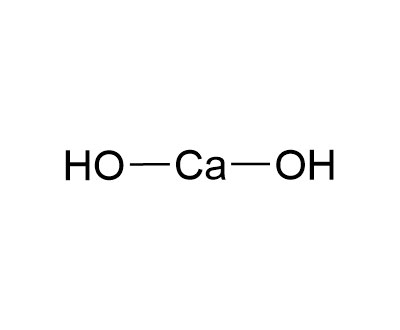

Calcium hydroxide, with the chemical formula Ca (OH) 2, commonly known as hydrated lime, lime water, hydrated lime, or calcined lime, is a white solid that is slightly soluble in water. Its aqueous solution is often called lime water (when in large quantities, it can form lime milk or lime slurry) and is alkaline. It absorbs carbon dioxide and water in the air to deteriorate, and is usually referred to as having water absorption properties. Generally used for the improvement of buildings or acidic soil. Basic information of calcium hydroxide
| Chinese name | 氢氧化钙 | English name | Calcium Dihydroxide |
|---|---|---|---|
| Chinese alias | 烧石灰;熟石灰;消石灰; | English alias | Cal;Slaked lime;Portlandite;Milk of lime;Calcium Hydroxide; 查看更多英文别名 |
| CAS | 1305-62-0 | Molecular formula | CaH2O2 |
| Molecular weight | 74.09270 | Accurate mass | 73.96810 |
| PSA | 40.46000 | LOGP | -0.35360 |
| EINECS | 215-137-3 |
|---|---|
| MDL | MFCD00010901 |
| RTECS | EW2800000 |
Appearance and characteristics:
White powder or colorless, slightly dull, aqueous solution
Density:
2.24 g/mL at 25 °C(lit.)
Boiling point:
2850 °C
Melting point:
580 ° C (dehydration, decomposition)
Refractive index:
four
Water solubility:
0.189 g/100 mL (0 °C); 0.173 g/100 mL (20 °C); 0.066 g/100 mL (100 °C)
Solubility:
Slightly soluble in water
Stability:
Stable. Incompatible with strong acids.
Storage conditions:
Low temperature ventilation and drying in the warehouse
RTECS:
EW2800000
Safety instructions:
S26-S39
WGK Germany:
one
Hazard category code:
R41
Customs code:
two billion eight hundred and twenty-five million nine hundred and nine thousand
Dangerous goods transportation code:
three thousand two hundred and sixty-two
Hazard category:
eight
Packaging grade:
III
Dangerous goods signs:
Xi
Signal words:
Danger
Danger signs:
GHS05, GHS07
Hazard prevention instructions:
P261; P280; P305 + P351 + P338
Hazard description:
H315; H318; H335
1. Lime digestion method: After calcining limestone into calcium oxide, it is selected and digested with water in a ratio of 1: (3-3.5) to produce calcium hydroxide feed solution. After purification, separation, and slag removal, it is centrifuged and dehydrated, dried at 150-300 ℃, and then screened (above 120 mesh) to obtain the final product of calcium hydroxide.
2. The hydroxide solution of alkali metal can be reacted with an aqueous solution of calcium salt to obtain calcium hydroxide. Dissolve 46g of calcium nitrate tetrahydrate in 500mL of distilled water that has been boiled to remove gas, cool to 0 ℃, and add 1mol/L potassium hydroxide solution (excluding CO2) multiple times while shaking. During the dropwise addition process, keep the solution at 0 ℃, filter and separate the precipitated Ca (OH) 2, wash it several times with 12L of water, and vacuum dry the precipitate in a sulfuric acid (relative density 1.355) dryer for 20 hours to obtain Ca (OH) 2.
3. Use diffusion method to prepare calcium hydroxide. Firstly, prepare two solutions: one is 30g of recrystallized CaCl2 · 6H2O dissolved in 50mL of water; Dissolve 12g of NaOH in 50mL of water and add a small amount of precipitated carbonate containing Ba (OH) 2 dropwise. Fill two 50mL beakers with each of the two solutions. Carefully place two beakers in the same container, 2cm away from the upper edge of the container. Cover the container lid and let it stand for 4 weeks. After that, needle shaped crystals of about 1cm will grow. Collect and filter them, wash them quickly with water, then wash them with dilute hydrochloric acid, water, ethanol, and ether in sequence. Finally, dry them at 110 ℃ in a short period of time.
4. Adopt lime digestion method. After calcining limestone into calcium oxide, it is carefully selected and digested with water in a ratio of 1:3.5 to produce calcium hydroxide material solution. After purification and separation to remove slag, it is then centrifuged and dehydrated, dried at 150300 ℃, and screened to obtain the finished product.
5. Dissolve the reagent calcium chloride in water to prepare a 25% aqueous solution, heat it to 80 ℃, and then add filtered 30% sodium hydroxide solution (which can exceed the theoretical amount by 30%) in portions to obtain calcium hydroxide. The resulting slurry mixture is filtered and washed, first washing away a large amount of Cl - ions with 0.1% sodium hydroxide solution, and then washing with distilled water until Cl - is qualified. The washed precipitate is dried at 8880-100 ℃.
1. Can be used as a raw material for producing calcium carbonate;
2. Can be used for painting walls and protecting tree trunks, etc;
3. High quality products are mainly used for the production of epichlorohydrin and epichlorohydrin;
4. It can be used in rubber and petrochemical additives, such as adding it to lubricating oil in the petroleum industry, to prevent coking, sludge deposition, neutralization and corrosion prevention;
5. Used for producing bleaching powder, bleaching powder essence, disinfectant, acid making agent, astringent, hard water softener, soil acidity inhibitor, depilatory agent, buffering agent, neutralizing agent, curing agent, etc.